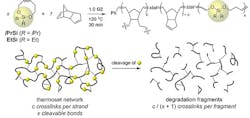Additive Eases Thermoset Recycling
Thermoset plastics are well known for their durability and heat-resistant qualities. However, the strong chemical bonds holding them together have thwarted efforts to break them down to allow recycling.
To more easily break down the materials but still retain their mechanical strength, chemists at the Massachusetts Institute of Technology (MIT), Cambridge, Mass., have developed a way to modify them using a cleavable comonomer.
The process involves adding silyl ether monomers to the liquid precursors that form the thermoset polydicyclopentadiene (pDCPD). The researchers discovered the silyl ether monomer, when included at a level of 7.5–10%, breaks down pDCPD into a soluble powder upon exposure to fluoride ions. The researchers next used the recycled powder to form a new pDCPD thermoset.
To demonstrate recyclability, the team dissolved thermoset fragments into fresh monomer and cured following standard protocols. An article in Nature (DOI: 10.1038/s41586-020-2495-2) contains more detail.
“The resulting recycled material showed mechanical properties similar or superior to that of fresh thermoset. Moreover, we anticipate that the poly-dicyclopentadiene fragments may find value in other ‘upcycling’-related applications. We are in the process of scaling up our recycling workflow, with a target of having these data ready by early next year,” say the researchers.
“That new material has nearly indistinguishable, and in some ways improved, mechanical properties compared to the original material,” adds Jeremiah Johnson, a professor of chemistry at MIT.
The material containing the cleavable comonomer could provide the same mechanical properties as material without the comonomer.
“Indeed, the mechanical properties were the same as well as the high temperature thermal stability. We did observe a modest decrease in the glass transition temperature when adding our comonomers to pDCPD. We are currently evaluating a few approaches to increase the glass transition temperature, which should readily address this potential issue,” notes Peyton Shieh, a postdoctoral fellow at MIT.
Figure 1. The introduction of x cleavable bonds within the strands of pDCPD with c crosslinks provides degradation fragments with ⟨c/(x + 1)⟩ crosslinks per strand. Source: Jeremiah Johnson, MIT.
“The cleavable monomer will provide a modest increase in the overall cost, on the order of ~10%, though this is only an estimate and with the identification of new synthetic routes it may be lower,” says Shieh.
“Moreover, this cost can become negligible in the context of composites, when high-value reinforcement materials such as carbon fiber are used,” he adds.
In addition, the researchers believe their approach could apply to a range of other plastics and polymers, such as rubber.
“This work unveils a fundamental design principle that we believe is general to any kind of thermoset with this basic architecture,” says Johnson.
“This will benefit all classes of thermosets, including thermoset plastics, elastomers, and gels. We could also install cleavable bonds into thermoplastics to render them degradable,” believes Shieh.
The team now is working on incorporating the cleavable comonomers into industrial resins: “In our manuscript, we demonstrated using cleavable monomers to make the industrial thermoset poly-dicyclopentadiene (pDCPD) degradable and recyclable. We are now exploring opportunities to commercialize our approach, including identifying strategic partners, to implement our approach on scale,” says Johnson.
The team also is in discussions to commercialize its silyl ether monomers for research use. An initial techno-economic analysis on the synthesis of the silyl ether monomer indicates a minor impact on the overall cost of material.
“Our comonomers can be viewed as ‘additives’, meaning they can simply be blending into an existing liquid resin and curing can follow the same manufacturing workflow without need for other changes. We hope that this approach will simplify adoption of the technology, since infrastructure changes should be precluded,” Johnson concludes.

